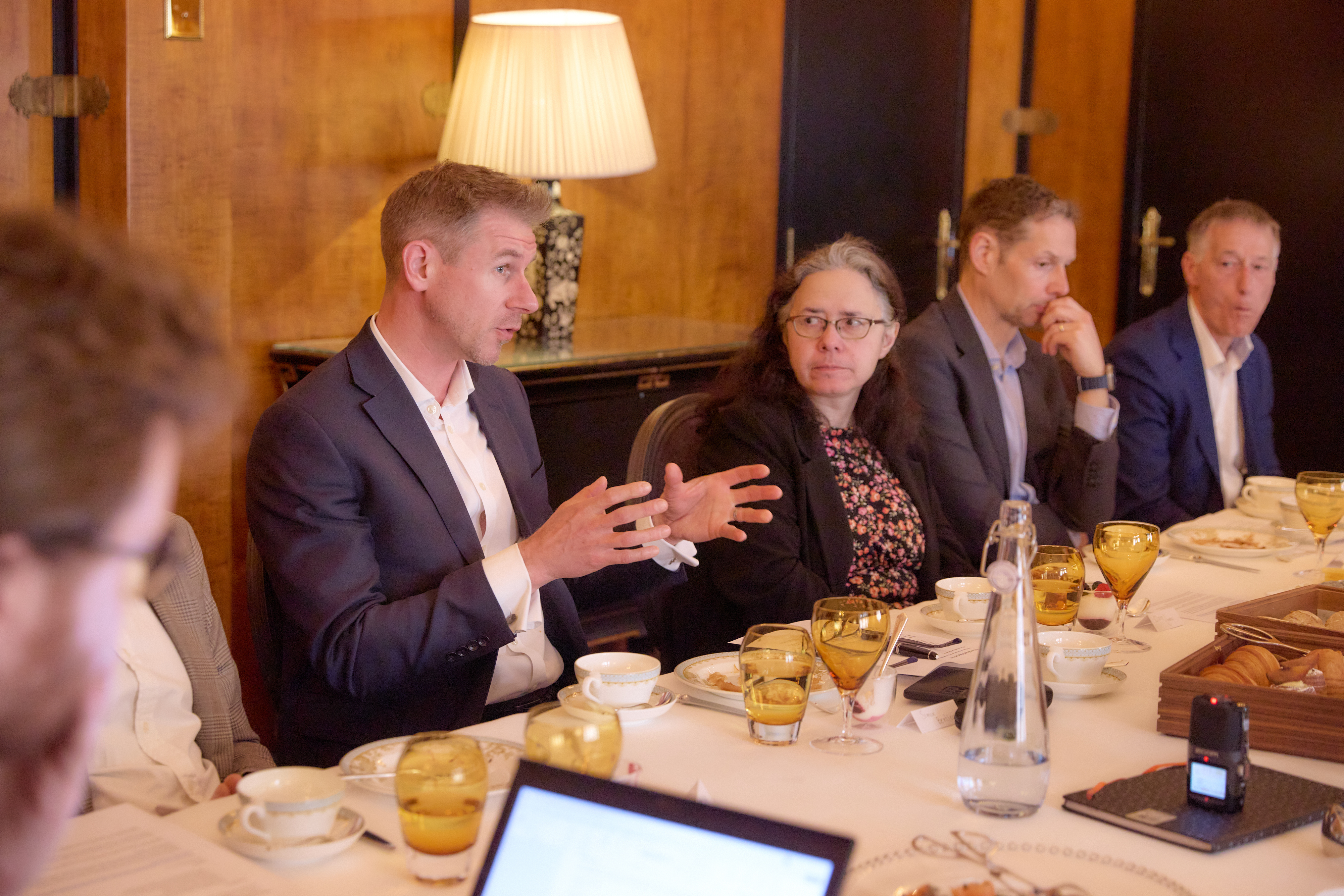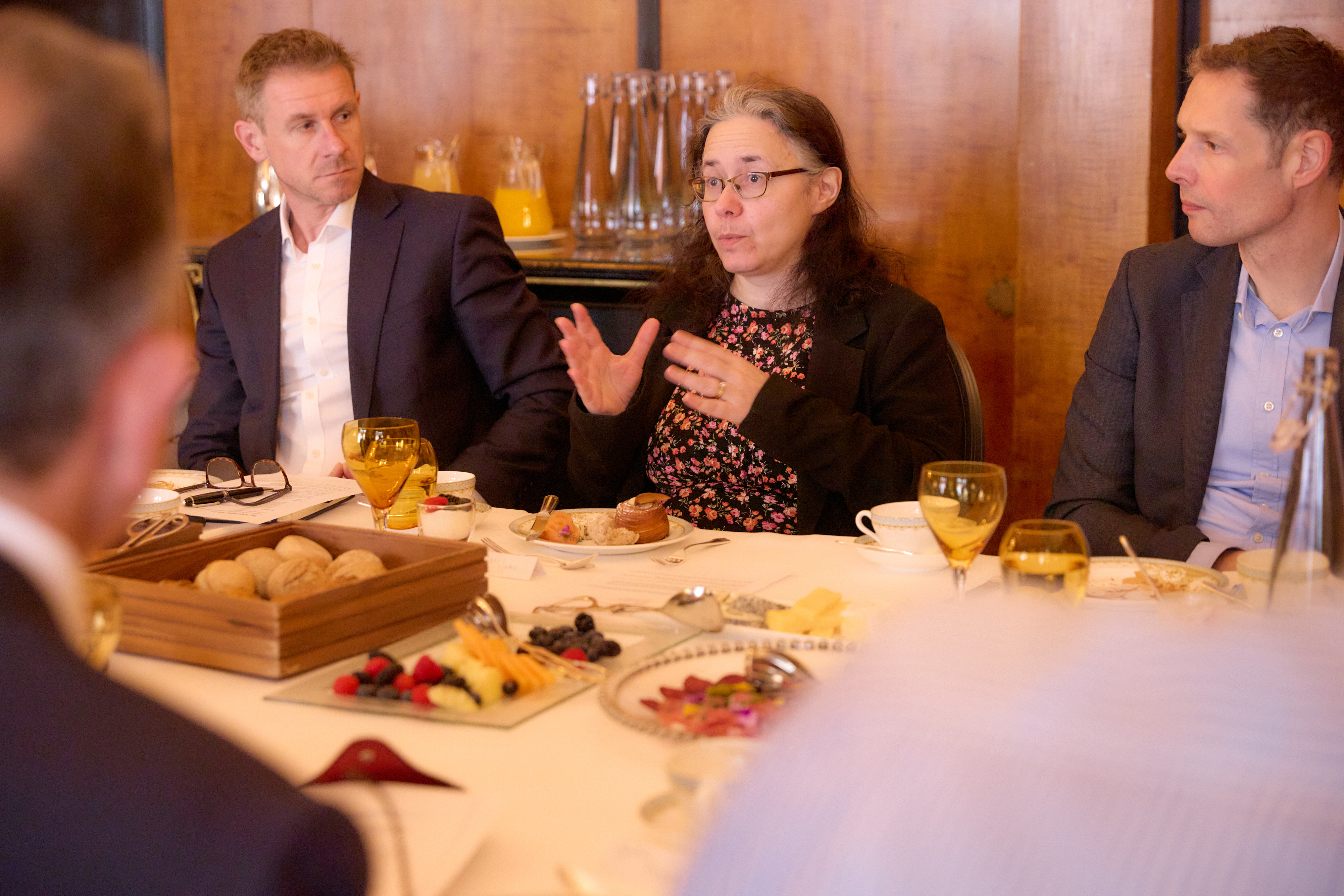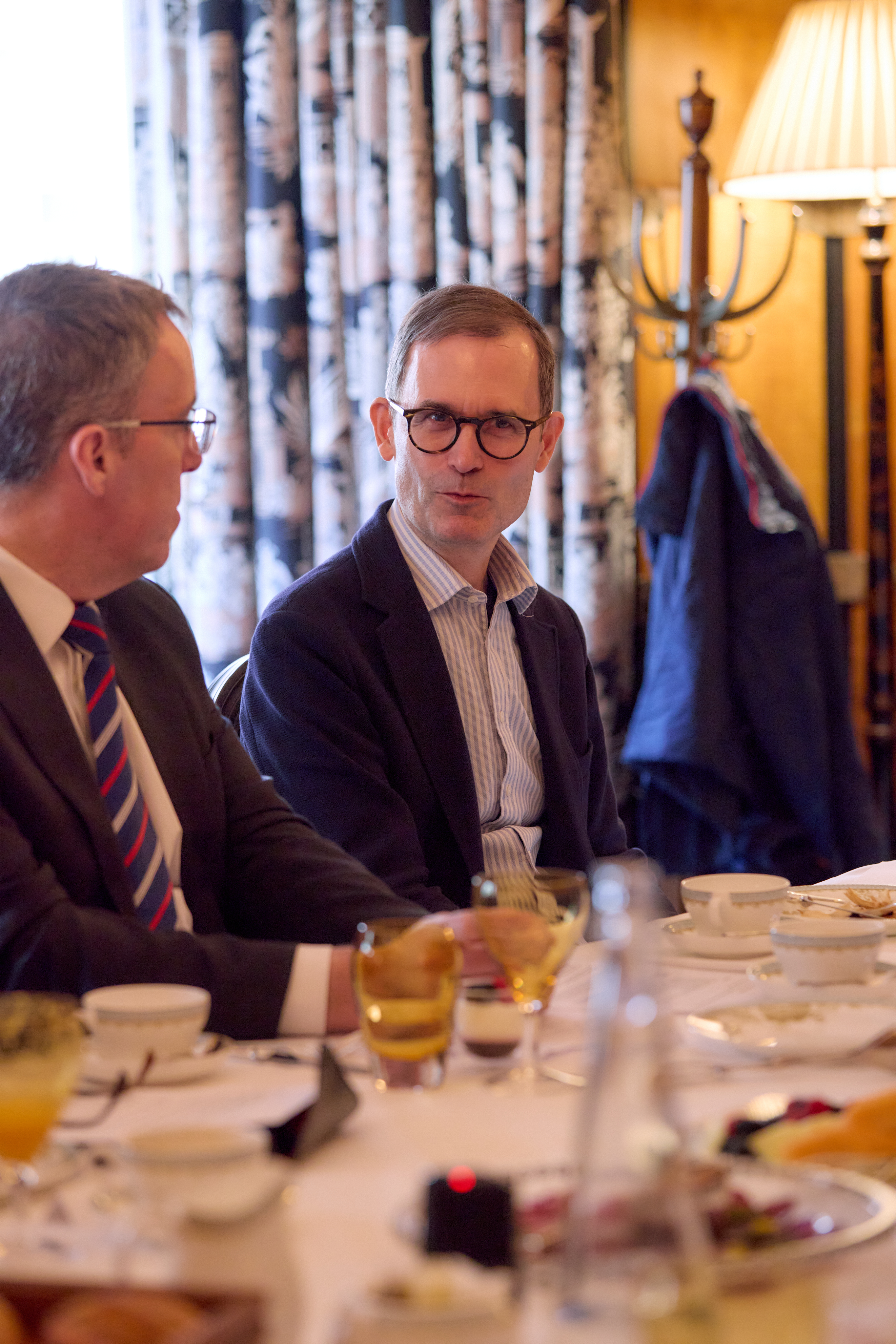
From left: Zedra professional trustee Clare James; Columbia Threadneedle Investments director of institutional business James Edwards; Vidett professional trustee Mike Birch; HS Trustees professional trustee Kevin O’Boyle; Pi Partnership professional trustee Donald Fleming; Law Debenture professional trustee Alan Baker; PP editor Jonathan Stapleton; Independent Governance Group trustee director Tim Giles; Columbia Threadneedle Investments head of UK solutions client portfolio management Simon Bentley.
At the beginning of April, Professional Pensions assembled a panel of experts to discuss the issue of run-on.
The roundtable – chaired by PP editor Jonathan Stapleton and held in association with Columbia Threadneedle Investments – looked at the extent to which schemes are considering run-on and the type of run-on they were considering.
Panellists also discussed what run-on could mean for investment strategy going forward and the potential role in such strategies of productive assets.
To what extent are schemes currently looking at run-on as an option, as opposed to other endgame options?
Tim Giles (Independent Governance Group): There are several schemes that pursue buy-in through buyout. Some have actively said they want to run on, but a lot of schemes are doing run on by default.
Alan Baker (Law Debenture): Many schemes are thinking about it, including some high-profile ones, but it is not clear how many are doing it. As trustees you don't want to rush into doing an insurance transaction when there are other options. Equally, you want to be talking to the sponsor about their views. Some schemes will run on, but for some it is just a pause to think about it.
Clare James (Zedra): I think that, where closed schemes are thinking about running-on, very few of these schemes have the intention of running-on into the long term – there are also, of course, some schemes that are still open to new entrants and future accrual.
Mike Birch (Vidett): There is a size issue, around £500m to make it worth covering all the costs of running the scheme. There is also a pause now regarding the possibility of government legislation this year, and how prescriptive or directional that will be. It makes sense to wait and see what the framework is.
Simon Bentley (Columbia Threadneedle Investments): Just over 50% of respondents to a survey from trustee groups and consultants said they were looking at running on. There must be a level of financial expertise within the trustee group and within the corporate sponsor. The stronger the funding position, the greater the appetite to run on.
Kevin O'Boyle (HS Trustees): The three schemes I am looking after are quite small, but they all seem to be quite happy to run on for now, although buyout at the appropriate time is the most likely endgame.
Clare James: For smaller schemes considering run-on, there are some challenges with the new scheme funding code. A smaller scheme is likely to want to meet the fast-track requirements and the reserve for ongoing long-term expenses can be prohibitively high, which may mean that the focus is more likely to turn to buyout.
Donald Fleming (Pi Partnership): It is about collaboration and dealing with pension schemes strategically. There is an evolving consensus that run-on is an option for some schemes, but we are not yet at the stage where people are saying, ‘I really want to run on'. It is currently almost accidental – a case of "let's keep our options open for a bit and work out where the land lies".

Where schemes are thinking about run-on, are finance directors (FDs) the driving force or trustees?
Tim Giles: For run-on to work it needs collaboration; the trustees and the company need to want it. If the FD's view changes and does not support it, it is hard to see how run-on is going to operate without FD wanting it to operate.
Alan Baker: Even if the FD wants to explore and pursue something like that, the general view is that it is only for a period. Whatever investment strategy and approach you take, you need to be able to pivot between insurance and run-on, because FDs change.
Simon Bentley: Certain businesses have to hold capital against any risk activities that they undertake; there is a cost of capital implication associated with that. That conversation has to involve the FD. Obviously, one needs to make sure that whatever investment risk is being run is commensurate with the risk the business is prepared to take and the available capital.
For those schemes looking at run-on, what are their key objectives? Is it largely defined contribution (DC) run-on?
James Edwards (Columbia Threadneedle Investments): There's a distinction. There is run-on with the explicit objective of surplus generation and to do something with that surplus, and run-on in a low-dependency or self-sufficiency mode and bide time to buyout. One requires a very active decision, and one is, ‘we are just going to carry on'. We need to be clear that there is self-sufficiency run-on, and then there is explicit surplus extraction generation run-on.
You could be talking millions of pounds realised at the point of the insurance transaction. If the employer can see some way of getting that back, either directly to the employer or shared with DC members – or enhance DB member benefits – then that is something to be considered.
Mike Birch: Some of the routes to take money out are complex. For the DC run-on piece, it is okay if you have a DC scheme, or if you then set up a new one, but that is quite a big thing to do.
Tim Giles: DC is easier to do, and the easy options to do typically get more traction. The hard options need to offer bigger benefits and provide companies with some reason to navigate the challenges.
What do you see as key challenges?
Donald Fleming: One thing to think about is the regulatory backdrop to this. If you look at the funding code, run-on seems as if it is just a passing thought - it is not the driving philosophy behind it, as I read it. If we are going to have new legislation or new support for run-on, then trustees are going to need a regulatory bedrock for good governance too, because otherwise we are in a bit of a vacuum.
Donald Fleming: One thing to think about is the regulatory backdrop to this. If you look at the funding code, run-on seems not to get much attention – it is not the driving philosophy behind it. So trustees are going to need a regulatory bedrock of support for the good governance of run-on too, because otherwise we are in a bit of a vacuum.
Kevin O'Boyle: However expensive you think your DB liabilities are, it is always more. Since the turn of the century there have been funding problems. Due mainly to luck, many DB schemes are better funded now than they have been for many years, but suddenly schemes think if they run on, they get this surplus back. But it can disappear as easily as it arose.
With things like GPPs and bulk transfers, simplification will help a lot of people in those type of schemes. For DB, I am concerned that if you run on with a plan of getting some money back eventually, a lot of people will be disappointed.
Clare James: As trustees, our duty is to ensure the security of accrued benefits. Once a scheme is sufficiently well-funded so as to be able to afford a buyout, I think it is then quite a difficult decision to run on. Run-on still involves taking risk and, whilst some risks such as interest rates, inflation and even mortality can be mitigated, there are some risks, such as the next Virgin Media/s37-type situation, that are not something the scheme can protect against. If a scheme is in the fortunate position to be able to afford to buyout, as a trustee you need to ask yourself ‘What would I say to the members if I run-on and something adverse happens and I didn't take the opportunity to secure the benefits when I was able to do so?'

The government's response to the DB schemes options consultation is due. What changes would you like to see to make extracting scheme surpluses, or run-on more broadly, easier?
Alan Baker: The ability to make one-off payments to members would make it easier to do something that would benefit members, while not causing accounting issues for the sponsor.
Mike Birch: It is going to be important where you benchmark it off. As a trustee, I would feel a lot more comfortable if it was at a level that is limited to your ability to buy out.
Donald Fleming: Sponsor covenant should play a role. Lower reliance is not ‘no reliance', but it is a diminishing reliance. It is quite difficult for a trustee board to take a strategic view of run-on if the implication is that there must be a background assumption of decreasing covenant reliance.
Clare James: There has been talk of some schemes, where there has been a history of discretionary increases, considering run-on with a view to generating additional returns to award additional benefits. However, discretionary increases often only affect a proportion of the membership. Some guidance around this type of situation would be helpful.
Is it tricky to decide how to share any augmentation of benefits between different member groups?
Kevin O'Boyle: If the end rules are pragmatic, rather than protecting to ensure that no one in any possible circumstance can lose out, there may be cases where you have run-on, you have paid some extra money to members, you have handed some money back to the sponsor, and it all goes belly up. You cannot protect against that, inevitably, whether it is through fraud or market circumstances. Putting trustees in the position of having to decide which members get what is easier said than done.

Can we still call buyout a gold standard?
Tim Giles: From a covenant piece it is at, or close to, a gold standard. There are a few ways of getting a stronger covenant. Administration is the interesting one. Are you going to get the customer service and the member experience from it? Insurers are working hard at that. There is still paternalism from some employers that they think they can do a better job.
James Edwards: Governance and risk management in the UK's DB system is light years ahead of where it was when we were last considering surpluses and risk. A lot of trustees could say, ‘We will hedge the assets to a minimum level of surplus and that is the absolute bare minimum that we need'. If you then add in longevity swaps, or ways to fully immunise the scheme, trustees and sponsors can have as much confidence as they can have that it is going to be well run and well protected into the future, and that members are not going to end up worse off.
Alan Baker: You need to be very comfortable that you have a very strong covenant to not go down the insurance route. It is a strong regime, and trustees do need to bear in mind those accrued benefits.
Tim Giles: Economically, if there is a prize to be had within pensions, you have to find a way of allowing it to distribute, or it just sits where it is. That is the government challenge, as much as anything else.
What does a good run-on investment strategy look like?
James Edwards: Arguably, not enormously different to where schemes are today. The FD does not want to have to put their hand back into their pocket to make good any deficit, so you are going to need high hedge ratios, whatever number gives people confidence from the trustee perspective, obviously the existing members are centre stage so we need to ensure those benefits are secure.
The important point is that the surplus accrued so far is effectively the covenant. It is not replacing the sponsor covenant, but it is what gives trustees the ability to have confidence in running on.
Simon Bentley: If you think of how we view the surplus, it can be a relatively low-risk investment strategy. You can also have a dynamic approach to risk-taking within the portfolio, because for as long as you are quite close to being fully funded, you want a very low-risk strategy to avoid suddenly becoming reliant on the corporate sponsor again. The further you get away from that and the bigger the surplus gets – within reason – the more investment risk you can take. If you can define a clear timeframe to run on, you can start allocating to some potentially slightly less liquid assets. You are then going to get better diversification and a better investment outcome.
Mike Birch: Employers are likely to start comparing the internal rate of return (IRR) for run-on against buying out and investing your share of the crystallised surplus into your business. As an employer, you could buy out now, and you could take that share of surplus and invest it in your business - or you could leave it in the scheme and get an investment return. Employers have not systematically started looking at it in that way yet, but if they do, will the return that they will get from run-on be enough to outweigh the IRR they could get from just taking it out and putting it into their business?
Tim Giles: We seem to be thinking DB must provide more DB. From a member's angle, if my DB benefits are secured then other ways of taking benefits might allow us to take more risk with surplus. There are more investment options within the pension scheme if you can find ways of giving surplus to the members which do not involve just giving it to them as a pension.
Alan Baker: Whatever you do, it is interesting that the return from the capital that the pension scheme represents on the balance sheet is not necessarily going to be as high as other investments. The pension scheme will likely still be a drag on the internal capital, even if you are extracting from it, particularly in financial services and other industries.

We have spoken about low-risk run-on; do productive UK assets play a role?
James Edwards: Yes, but when anyone has seen the various ministers over the last few years, even they cannot give you a definition of what productive finance is. I would say it is anything that contributes to UK jobs and GDP. That can be from a debt, infrastructure, equity or private equity perspective.
Realistically, UK DB funds are not going to be going for private equity, but there are plenty of infrastructure and property assets out there that can help with all sorts of issues in the UK, whether that is climate transition or productive finance, that actually fit very well into a DB pension fund's investment strategy in a pre-run-on and a run-on scenario without taking a lot of risk. People should be looking at infrastructure, property and credit.
Simon Bentley: The survey I mentioned earlier said the one area where investment allocations have reduced the most is in UK assets. So it doesn't feel likely that the balance of the last five to 10 years in terms of trustee allocations is going to change.
I also wonder if the government will try to come up with something that can steer investors towards not just productive finance in terms of infrastructure, but possibly defence spending in a way that also does not contradict any ESG restrictions that investors might have.
Alan Baker: Plenty of other countries have ‘carrots' for local investments for pensions schemes. It would be interesting to see whether the government might do something around stamp duty to encourage investment, rather than mandate.
Tim Giles: Yes. If you find ways of putting money back into the economy, then it will naturally flow towards productive finance.
When you design a run-on investment strategy, how do you design it to ensure that it can cope with a pivot in decision towards a different endgame?
James Edwards: It is about being explicit about your decision up front. If I am running on with a low-dependency portfolio that is relatively liquid – i.e. ‘I was probably going to do a buyout this year, but actually now I am going to run-on' – you cannot then decide in five years' time to go out and buy an illiquid infrastructure asset, and then five years' later suddenly decide to buyout. You need to be really explicit about your timeframe, and build the flexibility into that if you think you might wish to do a risk transfer at some point within the next 10 years.
The point around having a 10-year check-in is absolutely right – at this point, scheme size may have declined to the point where it just makes sense to buyout at that point. You need to be explicit about your decision, about what the strategy is up front and the timeframe around that. If you want to change your objective then arguably you are not running on to generate surplus, you are running on in self-sufficiency mode – that is a very different strategy to surplus generation.

What are your concluding thoughts and key takeaways following this discussion?
Alan Baker: The options have become broader for schemes. Some schemes will run-on but I suspect most schemes will still target insurance. That said, there are quite a few who are perhaps running on for a period to think about things. It has become quite a complex space and it will be important to see what the government and regulator say to help us make decisions, because at the moment it is quite hard without a bit more clarity.
Tim Giles: To echo Alan's point, schemes will run on. It will not be the majority; it will be the larger schemes that do it. There is potentially more effective use of capital that can be made to benefit both the members and the sponsor and therefore people should be considering it. That is the work to be done at the moment. Legislation can make the path a little easier.
Clare James: The discussion has just reinforced that this is a hugely complex area. I very much agree that the smaller schemes will go to buyout as the only really pragmatic solution. There will be a number of larger schemes that will run on, although even then a large number of those will ultimately buyout, even if that may be a few years down the line.
Mike Birch: There has been an interesting discussion about the investment approach and the value that is potentially there. For schemes of the right size, there is potentially something worth going through all of the complexity for. Where government can add real value is around how to get money out or get money to members in a sensible, easy, non-recurring way. If the government can solve that – which I think would be relatively straightforward – then that would be a big step forward, because having something that makes it worthwhile for the member in the scheme is going to be quite a driver to doing this.
Kevin O'Boyle: I agree; it is about getting the balance right for those schemes where it makes sense between members benefitting if money is also going out of the scheme to the sponsor. One should not underestimate the tax complexities around that at the moment. I am also still very curious about the fact that, unfortunately, trust rules are not the same – there are huge differences. I have seen ones where extracting surplus was solely the decision of the employer. At the other end, where the trustees have more of a say, I have seen it where trustees either do not consider it, or, in one scheme, they would only consider it if the scheme was funded to buyout plus. Solving the problem of statutory overrides is actually maybe a second‑level thing, but until there is some solution that makes it possible for the trustees to support the likely direction, it is not without its challenges.
Donald Fleming: Removing obstacles to allow trustees to take considered decisions would be a good thing. It is about policy consistency and appreciation of trustee decision-making constraints. Guidelines and regulations being put in place that impose more complexity into the system do not really help.
James Edwards: What I have heard from everyone here is that we are just crying out for something that simplifies matters, which is perhaps a bit of a Herculean ask of government, frankly, given their ability to overcomplicate matters. My plea would be for simple solutions for trustees, to make it easier to make decisions.
Simon Bentley: I agree with all the points that have been made. Looking at the investment strategy piece, it is going to be really important that trustees can make that definitive decision and determine whether they are running on and waiting for buyout pricing to come towards them – so a self-sufficiency approach – or running on to generate a surplus, because the investment strategy will be subtly different in both those scenarios.
If they choose to run-on to create a surplus, it is still a low-risk investment strategy, it is still a low‑dependency strategy. Such a strategy will have a high hedge level and is going to have a high allocation to credit-like assets. To the extent that you can set a clear timeframe, you can also make an allocation to supply more interesting, less liquid assets, to support growth over time.
Simon Bentley: I agree with all the points that have been made. Looking at the investment strategy piece, it is going to be really important that trustees can make that definitive decision and determine whether they are running on and waiting for buyout pricing to come towards them – so a self-sufficiency approach – or running on to generate a surplus, because the investment strategy will be subtly different in both those scenarios.
If they choose to run-on to create a surplus, it is still a low-risk investment strategy, it is still a low‑dependency strategy. Such a strategy will have a high hedge level and is going to have a high allocation to credit-like assets. To the extent that you can set a clear timeframe, you can also make an allocation to some more interesting, less liquid assets, to support growth over time.
This roundtable was held on 3 April 2025 in association with Columbia Threadneedle Investments






